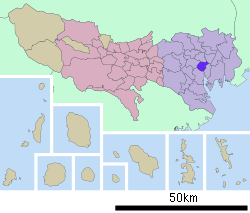Sophia University
Sophia University, (also known by its Japanese name, 上智大学, Jōchi Daigaku) is considered one of the top private research universities in Japan. According to the Times Higher Education, Sophia has the 20th place in its 2020 Japan University Rankings and is the top 4th private university in the country.[3][4] Founded by the Roman Catholic religious order of the Society of Jesus in 1913, the University has grown from its 3 original academic departments of Philosophy, German Literature, and Commerce to 9 undergraduate Faculties and 10 Graduate Schools, with over 13,900 students in total.[5][6][7]
上智大学 | |
 Bringing the World Together | |
| Latin: Universitas Sedis Sapientiae (University of the Seat of Wisdom) | |
| Motto | Lux Veritatis (Latin) 真理の光 (Japanese) |
|---|---|
Motto in English | Light of Truth |
| Type | Private Roman Catholic Research Coeducational Higher education institution |
| Established | 1913 |
| Founder | Society of Jesus |
Religious affiliation | Roman Catholic (Jesuit) |
Academic affiliations | AALAU, IAU, IFCU |
| Chairman | Toshiaki Koso |
| Chancellor | Fr.Tsutomu Sakuma, SJ[1] |
| President | Yoshiaki Terumichi, PhD[2] |
Academic staff | 1271 * 522 (Full-time) * 749 (Part-time) |
Administrative staff | 293 |
| Students | 13,435 |
| Undergraduates | 12,117 |
| Postgraduates | 1,153 |
Other students | 165 (Law) |
| Location | 7-1 Kioi-cho, Chiyoda , , Japan |
| Campus | Urban: -Yotsuya main campus -Mejiro campus -Shakujii campus |
| Alma Mater song | Sophia |
| Colors | Maroon |
| Nickname | Sophians |
| Sports | 8 varsity teams |
| Mascot | Eagle named Sophia-Kun |
| Website | www.sophia.ac.jp |
.svg.png) | |
Ever since Sophia was established, the University has been a leader in the internationalisation of Japanese universities. It had been conducting classes both in English and Japanese, and welcoming students from abroad from China, Korea, and even from Europe. Soon afterward, Sophia gained national repute as the leading institution in globalisation, foreign languages, and literature in Japan. As a prominent institution for research and higher learning in the fields of the social sciences, humanities, and natural sciences, the University has been selected by the Japanese Ministry of Education to be one of 37 universities to receive funding for its internationalisation efforts through the "Top Global University Project".[8]
Today, Sophia has international students from 77 countries. It also has forged agreements with 298 overseas universities in 59 countries. It also possesses student exchange programs with several other top universities throughout the world, including Georgetown University, Yale University, The University of Georgia, Sogang University, Hong Kong University, and the University of Cologne. Before 1957, the university only admitted male students to degree programs, but the numbers of male and female students are now more or less equal. Sophia's alumni are referred to as "Sophians"; they include the 79th Prime Minister of Japan, Morihiro Hosokawa, several politicians represented in the National Diet of Japan, and professors at various institutions.
Origins of the University Name
The name of the University is traced to letters of correspondence between two of the three founders of what would become Sophia University, Fr. James Rockliff, SJ and Fr. Hermann Hoffmann, SJ. The Japanese term 上智 ("higher wisdom" or "supreme wisdom", Jōchi) was the equivalent of the Latin word sapientia, which means wisdom. According to Catholic Church tradition, the term sapientia refers to the one of the Church's devotional titles for the Blessed Virgin Mary, the Seat of Wisdom.
When Joseph Eylenbosch, SJ began teaching Greek at the University in April 1924, he taught that the Japanese term jōchi was the equivalent of the Greek term σοφία (sofia). Afterwards, the students had proposed that the school be known as Sophia University.
Fr. Hoffmann, SJ, who was serving as University President at that time, initially opposed the proposal. However, he soon accepted the idea and submitted the proposal to Rome for the approval.
The English language-based, peer-reviewed academic journal Monumenta Nipponica, which was first inaugurated in 1938, identified itself as being published by Sophia University. The use of Sophia as the University name then became firmly established in Japan and overseas.[9]
History of the University
Early History
The origins of Sophia University could be traced to 1549 when Saint Francis Xavier, a prominent member and co-founder of the Society of Jesus, arrived in Japan to spread Christianity. In his letters to his fellow Jesuits, he had expressed hopes of establishing a university in Japan.[10][11]
During the so-called Kirishitan period of Japanese history, the Catholic Church had been responsible for establishing and administering educational institutions in Japan called Collegios and Seminarios, serving as bridges between the East and West.
The establishment of the University only began to take place more than 400 years from St. Francis Xavier's arrival in Japan. In 1903, three Jesuit priests from Europe came to Japan to continue the missionary work of the Church and to help establish Sophia University. One of the founders, Fr. Joseph Dahlmann, SJ from Germany, who had come to Japan via India, had listened to the requests of Catholics in the country, who expressed their desires to construct a Catholic university to serve as the cultural and spiritual base of the Church's missionary operations in Japan.
Fr. Dahlmann heeded the requests and sent a proposal to the then-Bishop of Rome, Pope Pius X, at the Holy See in Rome.
Dahlmann was then granted a private audience with the Pope in 1905 regarding the request. The Pius X promised to assign the Society of Jesus to create and administer a Catholic university in Japan. In Dahlmann's Latin memoirs regarding the encounter with the His Holiness, he recounted that the Pope spoke as follows: "Habebitis collegium in Japonica, magnam universitatem (in English: "You (plural) will have in Japan a college that is a great university".).
On that same year, the then-Bishop of Portland, Maine in the United States, William H. O'Connell, was appointed by the Pope to serve as a special ambassador of the Vatican to Emperor Meiji in Japan. O'Connell was also tasked to survey the situation in Japan. When he was granted an audience with Emperor Meiji, he had ascertained the education policy directions of the Japanese Education Ministry, and reported to officials at the Holy See regarding the possible establishment of a Catholic university in Japan.
At the 25th General Congregation of the Society of Jesus in held in Rome in September 1906, Pius X issued a formal written statement to the Jesuits to establish a Catholic university in Japan. Thus, the delegates at the Congregation voted unanimously in favour of the Pope's commands, and the first concrete steps were taken to prepare a university institution in the East.[12]
History of the University After Its Establishment
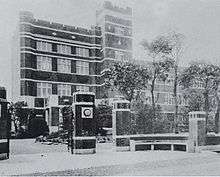
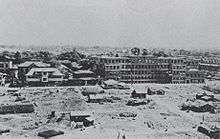
Sophia University was founded by Jesuits in 1913. It opened with departments of German Literature, Philosophy and Commerce, headed by its founder Fr. Hermann Hoffmann, SJ (1864–1937) as its first official president.[13]
In 1932, a small group of Sophia University students refused to salute the war dead at Yasukuni Shrine in the presence of a Japanese military attache, saying it violated their religious beliefs. The military attache was withdrawn from Sophia as a result of this incident, damaging the university's reputation in the eyes of the government of the Japanese Empire . The Archbishop of Tokyo intervened in the standoff by permitting Catholic students to salute the war dead, after which many Sophia students, as well as Hermann Hoffmann himself, participated in rites at Yasukuni. The Congregation for the Evangelization of Peoples later issued the Pluries Instanterque in 1936, which encouraged Catholics to attend Shinto shrines as a patriotic gesture; the Vatican re-issued this document after the war in 1951.[14]
Sophia University continued to grow by increasing the numbers of departments, faculty members and students, in addition to advancing its international focus by establishing an exchange program. Many of its students studied at Georgetown University in the United States as early as 1935. Sophia's junior college was established in 1973, followed by the opening of Sophia Community College in 1976. With the founding of the Faculty of Liberal Arts in 2006, Sophia University presently holds 27 departments in its eight faculties. Its current president is Yoshiaki Terumichi. Toshiaki Koso serves as head of its board of directors. Since 2008, the Global Leadership Program was started for students from four Jesuit universities in East Asia: Ateneo de Manila University in the Philippines, Fu Jen Catholic University in Taiwan, Sogang University in South Korea, and Sophia University in Japan.[15] In 2016 the University reached out to the four Jesuit junior-senior high schools in Japan, joining them in the Sophia College Corporation to help them pass on the Jesuit charism to their lay faculty through workshops and other assistance. These schools are Sophia-Fukuoka, Eiko Gakuen, Hiroshima Gakuin, and Rokko School.[16]
Sophia's Research Institutes Division includes 11 research institutes with about 200 researchers.
- Institute for Christian Culture
- Institute of Global Concern (IGC)
- Institute of Medieval Thought
- Iberoamerican Institute
- Linguistic Institute for International Communication
- Institute of Comparative Culture
- European Institute
- Institute of Asian, African, and Middle Eastern Studies
- Institute of American and Canadian Studies
- Institute for Studies of the Global Environment
- Institute of Media, Culture and Journalism[17]
Campuses
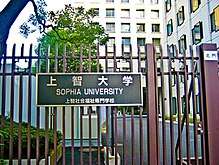
Sophia's main campus at Yotsuya is urban, consisting of roughly 25 large, modern buildings in the center of Tokyo. The majority of Sophia's 10,000 undergraduate students spend nearly all their time here. The faculties of Humanities, Law, Foreign Studies, Economics, Liberal Arts, and Science and Technology have their home here, as do the main library, cafeteria, gymnasium, chapel, bookstore, and offices. In April 2006, the Faculty of Comparative Culture (FCC), which had been located at the smaller Ichigaya campus, moved to the main Yotsuya campus and changed its name to the Faculty of Liberal Arts.[18] Nearly all of Sophia's foreign exchange and international students study at the FLA.
The Tokyo office of the Council on International Educational Exchange, the student exchange organisation, which oversees roughly half of the international students, is also based on the main Yotsuya Campus. The Shakujii (Tokyo) campus houses the Faculty of Theology. The Hadano campus in Kanagawa Prefecture is home to the Sophia Junior College, as well as a number of seminar halls and athletics complexes.[19]
Sophia School Corporation
Established in 1911, the Sophia School Corporation provides administrative support to academic institutions in its higher education division and secondary school education division, managing a total of 7 schools. In 1951, the Sophia School Corporation was then established as an academic legal entity according to provisions of the Private School Law.
| Higher Education Institutions | Secondary Education Institutions |
|---|---|
| Sophia University | Eiko Gakuen Junior and Senior High School |
| Sophia School of Social Welfare | Rokko Junior and Senior High School |
| Sophia University Junior College Division | Hiroshima Gakuin Junior and Senior High School |
| Sophia-Fukuoka Junior and Senior High School |
Academics
The University has 9 undergraduate faculties with 29 departments as well as 10 graduate schools with 25 programmes. With over 14,021 students as of 2017, the University provides academic opportunities for students from Japan and overseas to study in Japan. Sophia also possesses a wide-variety of English-taught academic programmes such as those provided by the Faculty of Liberal Arts (FLA). English programmes are also provided by the Faculty of Science and Technology (FST) through two programmes and the Green Science Programme, provided by the Department of Materials and Life Sciences, and the Green Engineering Programme, provided by the Department of Engineering and Applied Sciences.
| Faculty of Theology | Faculty of Humanities | Faculty of Human Sciences | Faculty of Law | Faculty of Economics | Faculty of Foreign Studies | Faculty of Global Studies | Faculty of Science and Technology | Faculty of Liberal Arts |
|---|---|---|---|---|---|---|---|---|
| Department of Theology | Department of Philosophy | Department of Education | Department of Law | Department of Economics | Department of English Studies | Department of Global Studies | Department of Materials and Life Sciences | Department of Liberal Arts |
| Department of History | Department of Psychology | Department of International Legal Studies | Department of Management | Department of German Studies | Department of Engineering and Applied Sciences | |||
| Department of Japanese Literature | Department of Sociology | Department of Legal Studies of the Global Environment | Department of French Studies | Department of Information and Communication Sciences | ||||
| Department of English Literature | Department of Social Services | Department of Hispanic Studies | ||||||
| Department of German Literature | Department of Nursing | Department of Russian Studies | ||||||
| Department of French Literature | Department of Luso-Brazilian Studies | |||||||
| Department of Journalism |
University Academic Research
Sophia University is a comprehensive research university with 9 undergraduate faculties with 10 graduate schools located on a single campus in Chiyoda, Tokyo. Leading higher education institutions in Japan toward globalisation and academic research, the University provides a strong international network of scholarship, attracting researchers and students from overseas to study in Japan.
As a research institution, the University established the Sophia Research Organisation (SRO) in April 2005 in order to promote and facilitate interdisciplinary and organisational research activities. The SRO possesses two research divisions: the Research Institutes Division and the Project Research Division. The University also has affiliated Research Organisations.
Simultaneously, Sophia's Centre for Research Promotion and Support provides additional support to general research activities and strengthens the a three-way collaboration initiative among industries, government, and academia. The Intellectual Property Rights Committee, established in 2005, ensures smooth collaborative support among the three individual groups and examines the inventions and intellectual properties of the researchers affiliated with Sophia University.[20]
| Academic Research Support | Research Institutes Division | Project Research Division | Affiliated Research Organisations |
|---|---|---|---|
| Sophia Research Organisation | Institute for Christian Culture | Nanotechnology Research Centre | Kirishitan Bunko Library |
| Centre for Research Promotion and Support | Institute for Medieval Thought | Centre for Islamic Studies | Monumenta Nipponica |
| Intellectual Property Rights Committee | Iberoamerican Institute | Sustainable Energy Research Centre | Sophia Asia Centre for Research and Human Development |
| Sophia Science and Technology Liaison Office (SLO) | Linguistic Institute for International Communication | Research and Development Centre for CAE Technologies Applied for Next-Generation Transport Aircraft Design | Institute for Grief Care |
| Institute of Global Concern | Microwave Science Research Centre | Semiconductor Research Institute | |
| Institute of Comparative Culture | Water-Scarce Society Information and Research Centre | Sophia University Institute of Bioethics | |
| European Institute | Sophia Institute for Human Security | Human Resource Centre for International Cooperation | |
| Institute of Asian, African, and Middle Eastern
Studies |
Institute of International Relations | ||
| Institute of American and Canadian Studies | |||
| Institute of Media, Culture, and Journalism | |||
| Institute for Studies of the Global Environment |
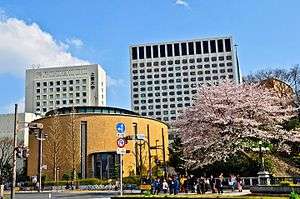
Academic rankings
| Toyo Keizai National[21] | General | 41 |
|---|---|---|
| WE National[22] | Employment | 8 |
| NBP Greater Tokyo[23][24] | Reputation | 4 |
| Shimano National[25] | Selectivity | SA |
| Social Sciences & Humanities | ||
|---|---|---|
| LAW | ||
| BE Success National[26] | Qualification | 17 |
| BE Pass rate National[27] | Qualification | 29 |
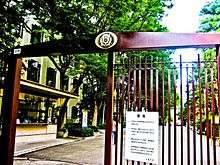
There are several rankings below related to Sophia University.
Alumni rankings
Alumni of Sophia have good employment prospects in Japanese industries. According to the Weekly Economist's 2010 rankings and the PRESIDENT's article on 2006/10/16, graduates from Sophia have the 8th best employment rate in 400 major companies, and the average graduate salary is the 6th best in Japan.[28][29]
Popularity and selectivity
Admission to Sophia is highly selective and competitive in Japan. As such it is considered as one of the top private universities along with Keio University and Waseda University. Typical acceptance rate is 5%.[30] Its entrance difficulty is considered one of the toughest along with Waseda and Keio among 730 private universities.[31][32][33]
Overseas Partner Institutions
Sophia University has student and academic exchange agreements with 374 overseas partner universities in 77 countries as of April 2020.[34]
Notable faculty
- Father Peter Milward, SJ, emeritus professor of English Literature
- Gregory Clark, former professor of economics; currently a Japan Times contributor
- Kuniko Inoguchi, former professor of law, and Permanent Representative of Japan to the Conference on Disarmament in Geneva
- Jun-ichi Nishizawa, electronic engineer, inventor and specially-appointed professor;
- Sadako Ogata, former professor of political science, and former United Nations High Commissioner for Refugees; currently serving as President of the Japan International Cooperation Agency
Notable alumni
Government, politics, and society
- Agnes Chan, singer and ambassador of the Japan Committee for UNICEF
- Kōichirō Genba, DPJ member of the House of Representatives and former Minister for Foreign Affairs
- Sumihiro Kuyama, former Chairman, Joint Inspection Unit, United Nations
- Yukari Sato, economist and LDP member of the House of Representatives
- Shoichi Kondo, DPJ member of the House of Representatives and former Senior Vice-Minister of the Environment
- Noboharu Yonenaga, politician
- Kuniko Inoguchi, political scientist and politician, member of LDP
- Seiko Noda, politician, member of LDP
- Takuya Hirai, politician, member of LDP
- Seiichirō Dōkyū, politician, member of DPJ
- Yoshio Maki, politician
- Li Linsi, Chinese diplomat, educator, diplomatic consultant to Chiang Kai-shek
- Toshitsugu Saito, politician, 65th and 66th Minister of Defense
- Morihiro Hosokawa, 79th Prime Minister of Japan
- Mukhriz Mahathir, 11th Menteri Besar of Kedah, Malaysia
- Rizal Ramli, 3rd Coordinating Minister for Maritime Affairs of Indonesia
- Carlos Holmes Trujillo, former Colombian Minister of Foreign Affairs and current Colombian Minister of Defense
Academia
- Ruben Habito, associate professor at Southern Methodist University
- Yuya Kiuchi, sport and pop culture scholar at Michigan State University
- Fidel Nemenzo, mathematician, chancellor of University of the Philippines Diliman
- Junko Shigemitsu, theoretical physicist, emerita professor at Ohio State University
- Kyouichi Tachikawa, historian
- Takayuki Tatsumi, American literature scholar at Keio University
- Dominique Turpin, Dean & President of IMD, Switzerland
- Shōichi Watanabe, English scholar
Business
- Hassan Jameel, Saudi businessman
- Johnny Kitagawa, founder and CEO of Johnny & Associates
- Shawn Layden, President & CEO of Sony Interactive Entertainment America
- Peer Schneider, Co-founder and SVP/Publisher at IGN Entertainment
- Shuzo Shiota, CEO and president of Polygon Pictures
Media and literature
- Jake Adelstein, journalist, consultant, and author of Tokyo Vice
- Beni Arashiro, singer
- Yoshitaka Asama, screenwriter and film director
- Vernon Grant, first American cartoonist to introduce manga concepts to English-language readers
- Boyé Lafayette De Mente, author on Japanese culture ('54)
- Kōichi Mashimo, anime director, founder of studio Bee Train
- Yuriko Nishiyama, manga writer, including Harlem Beat
- Maureen Wartski, author, including A Boat to Nowhere and Yuri's Brush with Magic
- Robert Whiting, author on Japanese culture, including The Chrysanthemum and the Bat and You Gotta Have Wa about Japanese baseball
- Yūki Yamato, Japanese screenwriter and director
Others
- Kurara Chibana, Miss Japan 2006 and 1st Runner-up at Miss Universe 2006
- Tina Chow, model and jewellery designer[35]
- Bruce Frantzis, Taoist Master, USA
- Yū Hayami, actress, singer
- Sumire Uesaka, anime voice actress
- Carrie Ann Inaba, American dancer, choreographer, actress, and singer
- Hisashi Inoue, author
- Maiko Itai, Miss Universe Japan 2010 winner
- Crystal Kay, singer
- Stephen Kim Sou-hwan, Korean Roman Catholic cardinal and Archbishop of Seoul
- Peter Shirayanagi, Japanese Roman Catholic cardinal and Archbishop of Tokyo
- Saori Kumi, author
- Alan Merrill, a 1960s Group Sounds pioneer gaijin tarento and later composer of the classic song "I Love Rock N Roll"
- Osamu Mizutani, high school teacher, famous for his book "Yomawari Sensei" and his efforts to redress delinquents
- Father Adolfo Nicolás, S.J., Superior General of the Society of Jesus
- Hikaru Nishida, actress, Japanese drama
- Judy Ongg, singer/actor
- Zomahoun Idossou Rufin, a gaijin tarento, philanthropist and diplomat who has been Benin's Ambassador to Japan and the Philippines
- Emyli, singer
- George Takei, Japanese-American actor most famous for his role as Star Trek's Mr. Sulu
- Tadashi Yamamoto, Founder of the Japan Center for International Exchange and the Shimoda Conference
- Michelle van Eimeren, Miss Universe Australia 1994
References
- https://www.sophia.ac.jp/eng/news/2018/0402news.html
- https://www.sophia.ac.jp/eng/news/2016/1117001.html
- Bothwell, Ellie (24 March 2020). "Japan University Rankings 2020: results announced". Times Higher Education. United Kingdom: Times Higher Education. Retrieved 11 April 2020.
- "Best private universities in Japan". Times Higher Education. United Kingdom: Times Higher Education. 24 March 2020. Retrieved 11 April 2020.
- "Sophia University Graduate Students 「上智大学大学院学生数」" (PDF). Sophia University. Chiyoda, Tokyo, Japan.: Sophia University. 2018. Retrieved 13 March 2020.
- "Sophia University Undergraduate Students「上智大学学部学生数」" (PDF). Sophia University. Chiyoda, Tokyo, Japan: Sophia University. 2018. Retrieved 13 March 2020.
- "History of Sophia University: Arrival of St. Francis Xavier-1967". Sophia University. Chiyoda, Tokyo, Japan: Sophia University. Retrieved 13 March 2020.
- "Top Global University Project Japan". Top Global University Project Japan. Chiyoda, Tokyo, Japan: Ministry of Education, Culture, Sports, Science and Technology. Retrieved 11 April 2020.
- "Origins of the school name; the school emblem and school flag; the school colors and school song, No. 41" (PDF). Sophia University. Chiyoda, Tokyo, Japan: Sophia University. April 2016. Retrieved 11 April 2020.
- "Arrival of St. Francis Xavier--1967". Sophia University. Chiyoda, Tokyo, Japan: Sophia University. Retrieved 11 April 2020.
- "Saint Francis Xavier and the Roots of Christianity in Japan". Nippon.com. Minato, Tokyo, Japan: Nippon Communications Foundation. 27 August 2015. Retrieved 11 April 2020.
- Luhmer, SJ, Klaus. "The Society of Jesus and the founding of Sophia University". Sophia University. Chiyoda, Tokyo, Japan: Sophia University. Retrieved 11 April 2020.
- "Hoffman".
- Breen, John (1 March 2010). "Popes, Bishops and War Criminals: reflections on Catholics and Yasukuni in post-war Japan". The Asia-Pacific Journal: Japan Focus. Retrieved 15 January 2014.
- Profile, hompi.sogang.ac.kr; accessed 22 September 2014.
- 日本管区. イエズス会日本管区 [The Society of Jesus - Japan Province]. www.jesuits-japan.org (in Japanese). Retrieved 2017-08-16.
- "Research Institutes Division". Sophia University. Retrieved 4 May 2018.
- "FLA". Retrieved October 13, 2015.
- "Hadano".
- "Sophia University: a Japanese university with a global mission" (PDF). Sophia University. Chiyoda, Tokyo, Japan: Sophia University. April 2018. pp. 1–25. Retrieved 11 April 2020.
- "Truly Strong Universities" (in Japanese). Toyo Keizai. 2010. Retrieved April 29, 2011.
- "Employment rate in 400 major companies rankings" (in Japanese). Weekly Economist. 2011. Retrieved April 29, 2011.
- "Nikkei BP Brand rankings of Japanese universities" (in Japanese). Nikkei Business Publications. 2010. Retrieved April 29, 2011.
- "Nikkei BP Brand rankings of Japanese universities" (in Japanese). Nikkei Business Publications. 2009. Retrieved April 29, 2011.
- "GBUDU University Rankings" (in Japanese). YELL books. 2009. Retrieved April 29, 2011.
- "Bar Exam Successful Applicants rankings" (in Japanese). Shikaku Seek. 2010. Retrieved May 11, 2011.
- "Bar Exam Pass rate rankings" (in Japanese). Shikaku Seek. 2010. Retrieved May 11, 2011.
- "Employment rate in 400 major companies rankings" (in Japanese). Weekly Economist. 2011. Retrieved April 29, 2011.
- http://hensachi-ranking.seesaa.net/article/26733115.html#more
- http://www.sophia.ac.jp/jpn/admissions/gakubu_ad/gakubu_news/110117/2011ippan_syutuganjyokyo
- National and Public universities apply different kind of exams. so it's only comparable between universities in a same category.
- e.g., Yoyogi seminar published Hensachi (the indication showing the entrance difficulties by prep schools) rankings http://www.yozemi.ac.jp/rank/gakubu/index.html
- Japanese journalist Kiyoshi Shimano ranks its entrance difficulty as SA (most selective/out of 11 scales) in Japan. 危ない大学・消える大学 2012年版 (in Japanese). YELL books. 2011.
- "上智大学は2020年4月1日現在、77 国・地域の374大学と協力に関する覚書(MOU)や交換留学協定を締結しています". Sophia University. Chiyoda, Tokyo, Japan: Sophia University. April 2020. Retrieved 11 April 2020.
- Lambert, Bruce (January 26, 1992). "Bettina L. Chow, Model and Designer, Dies at 41". nytimes.com.
External links
- Sophia University Homepage (in Japanese)
- Sophia University Homepage (in English)
- Sophia University Old Homepage (in English)
- Sophia University Faculty of Liberal Arts (FLA) Homepage (English only)
